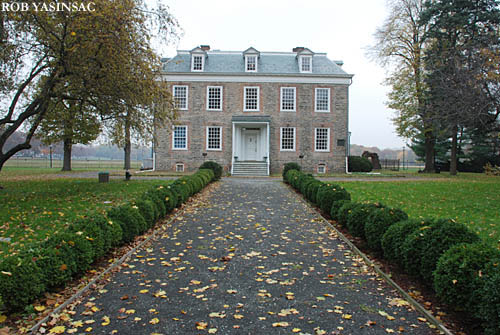
Frederick van Cortlandt House (ca.
1748-9)
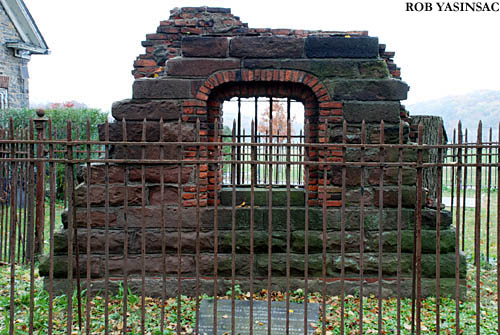
Re-created ruin: Prison window from "old Sugar
House," Duane Street, New York City (1763-1892).
Used by the British as a prison for American soldiers (1776-1783).
Van Cortlandt Park
BRONX, NY

Frederick van Cortlandt House (ca.
1748-9)

Re-created ruin: Prison window from "old Sugar
House," Duane Street, New York City (1763-1892).
Used by the British as a prison for American soldiers (1776-1783).
Van
Cortlandt Park in the Bronx is host to a number of sites of historic significance
and even some ruins. The Van
Cortlandt House, once a home to one of New York's early merchant families,
is open to the public for tours, which are very visitor-friendly (one can take a
self-guided tour, and photography is allowed). Up on a rocky outcrop north of
the mansion is Vault
Hill, built shortly after the death of
Frederick van Cortlandt in 1749 as a family burial plot. During the Revolutionary War, City Clerk Augustus Van Cortlandt hid the city records from the British
Army in the vault, which is no longer occupied. It was unfortunately strewn with garbage and overgrown during
our visit.
Perhaps more significant but neglected by history is the
fact that the site was the 17th-century farmstead of Adriaen van der Donck, the Yonkheer,
a Dutch immigrant whose legal knowledge and social tolerance helped shape New
York's, and America's, identity and character, over a century before the Founding
Fathers appeared on the scene. (By no small coincidence was Van der Donck
forgotten and the Washingtons, Jeffersons, Franklins and the like mythologized -
they were of English stock and on the winning side of the Anglo-Dutch conflict for
control of the American colonies in the mid-1600s.) It is thought that Van der
Donck was killed in 1655 by Native Americans who raided the area (then part of
the Dutch colony known as New Netherland) in response to Peter Stuyvesant's
defeat of their allies in New Sweden (Delaware). According to author Russell
Shorto, the "site of the supposed Van der Donck house is just behind the
gardens of the Van Cortlandt House." However, the foundations (not
visible today) were
badly damaged by a sewer trench dug through the site in 1910. To learn more
about the fascinating story of Adriaen van der Donck and the birth of New York,
read Shorto's book "The
Island at the Center of the World."
The vanished Putnam Division
of the New York Central Railroad still passes through the park too. The railroad
ran between Sedgwick Avenue in the Bronx to Brewster, New York. Much of the
right-of-way is a walking path today, known in Westchester County as the
North/South County Trailways and in Van Cortlandt Park as the John Kieran Nature Trail.
The station platform overhang survives in Van Cortlandt Park, the only such ruin
of its kind from this railroad to survive. More common are the old bridges,
which still function for pedestrians and cyclists who use the old roadbed as a
linear recreational park.
VAN CORTLANDT PARK "RUINS":
GRAND CENTRAL TERMINAL TEST PILLARS
Before
constructing the new (and still current) Grand Central Terminal (finished in
1913), the New York Central Railroad set up thirteen pillars made of different
stone alongside the Putnam Division tracks. After comparative evaluation,
one particular type of stone was chosen for use in Grand Central. I
have heard and read that it was either the stone used in the northernmost or
southernmost pillar that was selected - people seem to agree that "the last
one" was used but never say at the north or at the south. Today, the pillars have been painted
gray, perhaps to cover up years of graffiti, so it is hard to properly compare
them now to the stone at Grand Central Terminal.
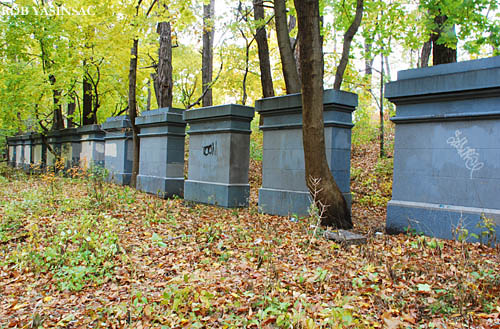
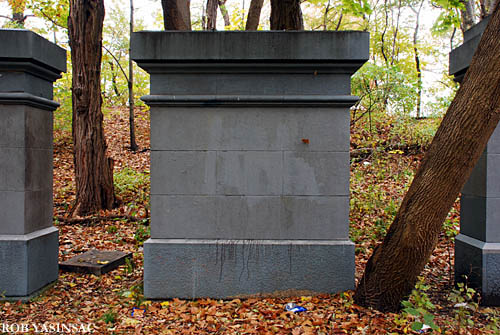
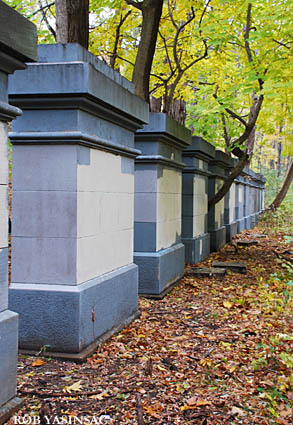
Many thanks to Don Bayley of BrickCollecting.Com
for the tour of Van Cortlandt Park.
Yaz’ Hudson Valley Ruins and Abandoned Buildings, etc.
This page copyright © 2007 by Robert J. Yasinsac.
Reproduction of these photos without the permission of Robert Yasinsac is prohibited.